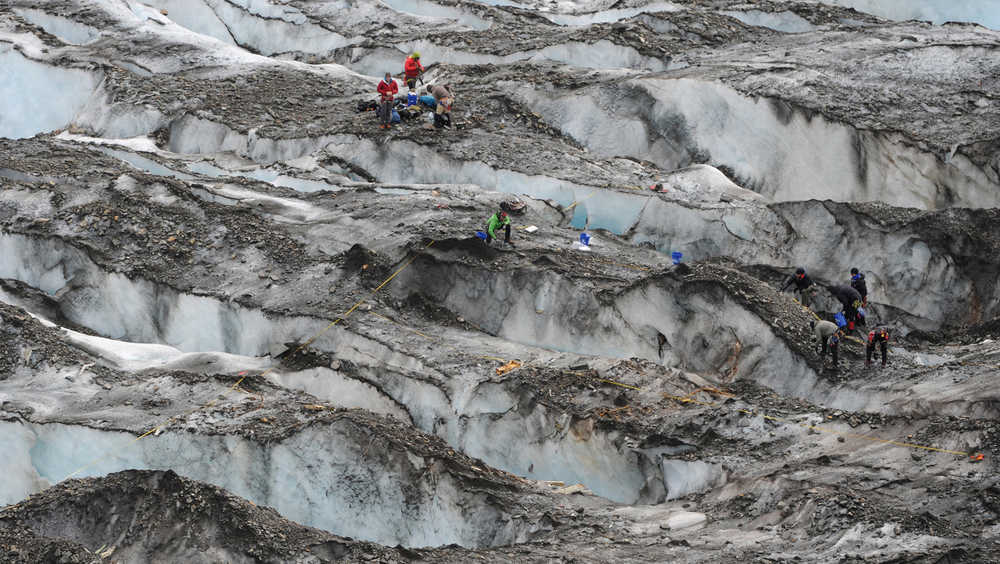COLONY GLACIER — Scientists and volunteers tethered in safety gear and ice cleats painstakingly scoured the frozen dirt and ice to see if a glacier had given up any more of its dead before they are swept into a lake and lost to history.
Fifty-two service members died when their airplane smashed into an Alaska mountain more than 60 years ago. The wreckage was rediscovered in 2012, and the somber recovery effort resumed this month.
“It’s a patriotic duty that we’re doing up here to the family members of the service members that have paid the ultimate sacrifice for their nation,” U.S. Navy Lt. Commander Paul Cocker said.
The C-124 Globemaster was heading from McChord Air Force Base in Washington state to Elmendorf Air Force Base in Anchorage when it vanished Nov. 22, 1952, with 41 passengers and 11 crew members. The wreckage was found soon after but became buried in snow, forgotten and eventually part of the glacier at the bottom of Mount Gannett.
An Alaska Army National Guard helicopter flying over the glacier, about 50 miles northeast of Anchorage, rediscovered the wreckage in 2012. Recovery efforts have been undertaken each summer, and the remains of 17 service members have so far been identified and returned to their families for burial.
Now, the race is on to recover as many remains as possible before the relatively fast-moving glacier, advancing about a couple hundred meters a year, deposits the wreckage in nearby Inner Lake George.
The search area, which covers about 3 acres, is near the toe of the glacier, and the leading edge is constantly being cleaved off and pushed into the lake.
“There is no way to know for sure when all of the remains and wreckage will be lost to the lake, this is why we’re dedicated to doing all that we can now,” Capt. Anastasia Wasem, an Air Force spokeswoman, said in an email.
About 12 people, both civilians and military members, have been at the glacier nearly every day since early June looking for remains and collecting plane wreckage. This year’s effort is scheduled to end Friday. Any remains found will be sent to an armed forces DNA lab in Delaware for identification.
This is the fourth summer on the glacier for Roy Adkins, a civilian working to recover plane wreckage for the military. Those searching each year have become accustomed to the changing landscape.
“Every year we come out here, there’s more and more debris and in different areas,” Adkins said. “We’ve left on a Friday and came back on a Monday, and debris fields have shown up.”
Chief Warrant Officer 4 Bryan Keese of the Alaska Army National Guard ferries workers to the glacier on a UH 60 Black Hawk helicopter from Joint Base Elmendorf-Richardson in Anchorage.
He was flying a similar helicopter four years ago when his crew chief, Sgt. Roman Bradford, spotted some yellow fabric on Colony Glacier. That turned out to be a life raft from the Globemaster. A check of the crash database narrowed down the possibilities, and a crew returned to the glacier to find a log book and dog tags, identifying the wreckage from the 1952 Globemaster.
“It’s pretty cool to get these folks back home to where they belong,” Keese said.
Tonja Anderson-Dell of Tampa, Florida, has researched the crash for years. Her grandfather, then 21-year-old Isaac Anderson, died in the crash but his remains have not been identified.
She said the military has told families that some remains and debris might have gone into the lake already, and it worries her that the remains of all 52 men won’t be found.
If her grandfather’s remains are never identified, she has some solace, thanks to Keese.
He and others collected wreckage shortly after the discovery. Anderson-Dell and other family members traveled to Alaska to view the materials, including a mailbox that still had a lock attached. They were allowed to take metal pieces home. She says hers still smells like diesel fuel.
“For the families, that means a lot because some of us may never bring our guy home, but we still have a piece of that plane that they died in,” she said.

